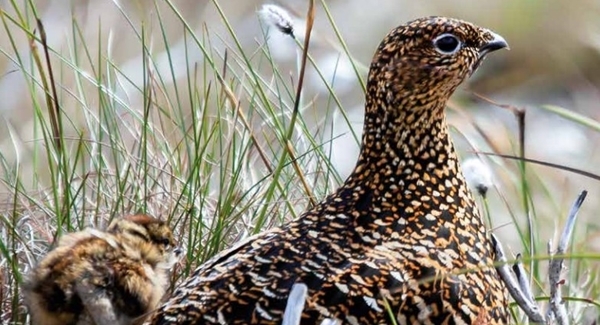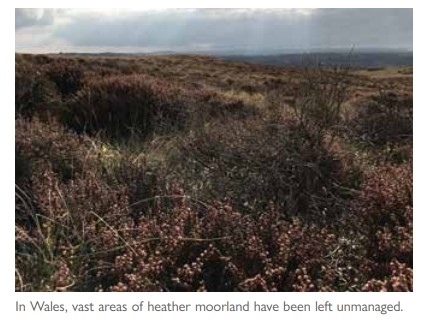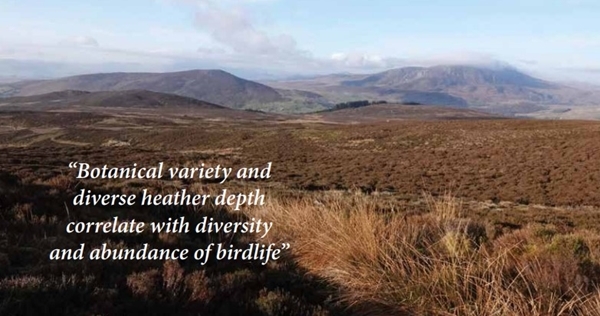
This case study is taken from our Real Wilders book, which you can download here or you can buy a print copy here.
When habitat and predation management ended, the Berwyn Hills fell silent, but with the right approach, birdlife can be restored.
With the advent of driven grouse shooting in the 19th Century, many moor owners in Wales chose to prioritise management for grouse over farming or forestry. This provided employment for gamekeepers, who produced the mosaic habitat of different heights and types of vegetation alongside predator management to increase the numbers of grouse. It was so successful that it funded grand sporting lodges, tracks to access the moor and even train stations.
After the Second World War, the government’s focus turned to combatting food shortages, and grants incentivised more intensive agriculture. This resulted in a rapid increase in grazing and draining along with large areas of upland being planted with commercial forestry to address the national shortage of timber. It is estimated that Wales lost 46% of its heather habitat during that dramatic change and driven grouse shooting all but disappeared.
The importance of predator control
The end of grouse management on the Berwyn uplands of North East Wales provides a lesson on the negative impact on ground-nesting birds when habitat and predator control is removed. The Warren & Baines study published in 2012 documents dramatic declines in the breeding numbers of red-listed species in North Berwyn between 1983 and 2002.
In just 30 years, breeding lapwing were no longer found within the sample survey squares, golden plover were 90% fewer, curlew 79%, ring ouzel 80%, black grouse 78% and red grouse 54%. In contrast, over the same period carrion crow, a generalist predator species classified as of ‘least concern’ by the IUCN Red List, experienced an increase of 526%.
Ornithologist Keith Offord, who has conducted continuous monitoring and observations of birdlife on the Berwyn since the 1970s, has serious concerns about the impact of predation on red-listed species. He said: “I used to take curlew for granted and could never have predicted the disastrous decline in their breeding population, which has taken place over recent decades. I have no doubt that the burgeoning corvid population, especially on surrounding farmland and forests, has been a significant driver of this decline. Other ground-nesting moorland species including hen harrier are equally at risk from corvid and fox predation. This season, I was monitoring a hen harrier nest under licence. From a distance of around 350 metres, I observed the adult female leave the site where she was incubating eggs. A passing crow obviously spotted the white eggs and dropped like a stone onto the nest. Fortunately, I was able to intervene, scaring the crow away and the pair went on to fledge four young.”
Keith’s view is backed by peer-reviewed research, including the GWCT’s 2010 Upland Predation Experiment, which found an average threefold improvement in breeding success in lapwing, golden plover and curlew, when predator control was carried out alongside habitat maintenance. Conversely, the study showed that, without predator control, fledging rates fell below sustainable levels, meaning that these species would continue their decline to local extinction as they are currently doing in Wales.
The potential of grouse management for biodiversity
Further research conducted by the RSPB noted that: “Curlew population changes over an 8-10-year period were positively related to gamekeeper density (a surrogate of predator control intensity).” Yet, in spite of this, the RSPB has failed to reverse the decline of many red-listed species on its Vyrnwy Reserve, which includes a former grouse moor, in the Berwyn Special Protection Area (SPA). Despite valiant efforts and the considerable cost of improving breeding habitat for curlew over 441 acres, their number on the reserve continue to decline and data indicates predation as the limiting factor in improving productivity.
Like Vyrnwy, there has been no meaningful predator control conducted on nearby Pale Moor, which is run by Natural Resources Wales and the annual grouse counts on both reserves indicate numbers at very low levels. The contrast with Ruabon and Llanarmon, private estates, also within the Berwyn SPA where grouse management has been continued, is striking. Pale has 6.7 grouse per km2 and Vyrnwy only 4.2, in contrast with a stable population at Ruabon of 16.1 grouse per km2 and 15.8 per km2 at Llanarmon.
Grouse are now red-listed as ‘critically endangered’ in Wales, and they could be regarded as an indicator species for the health of Welsh upland habitats. Many experts across the conservation sector now recognise the need to integrate effective predation management with the restoration of a mosaic of dwarf shrub habitat, to prevent the extinction of Wales’s most threatened moorland birds. Keith Offord is emphatic about the need for controlled burning and cutting to improve habitat.
He said: “My surveys of areas of varying management show that botanical variety and diverse heather depth correlate with diversity and abundance of birdlife. While I understand concerns regarding peat and carbon capture, opponents of traditional management practices, such as controlled burning, offer few, if any, practical alternatives to maintain diversity, protect against wildfire, and prevent heather moorland simply reverting to forest with the subsequent potential impact on all species dependent on this habitat.”
The new generation of moor owners and keepers
As well as cutting and managed burns, ecologist Nick Myhill, who works with local farmers on common land in Powys, has shown that grazing both sheep and, importantly, cattle also plays a vital role in moorland restoration. Cattle graze in a complementary way to sheep, tackling monocultures of molinia grass to allow more varied vegetation to return, and their heavy hooves create pools that benefit invertebrates and sphagnum moss.
Nick has employed novel technologies such as no-fence GPS collars that enable the careful management of grazing pressure. He said: “The majority of our Welsh uplands won’t be restored with sheep alone. On common land, hardy cattle wearing GPS collars can be more easily kept within each graziers’ heft. They turn molinia back to high nature-value grassland, complementing bracken control measures, and opening up wetlands for wildlife.”
Will Duff Gordon runs Ireland moor, which was part of the Powys Moorland Partnership, a Sustainable Management Scheme (SMS) funded by Welsh Government with the aim of reinstating active moorland management to increase biodiversity. He believes that, with the right kind of support, both financial and by being allowed to use the full range of conservation measures, grouse management integrated with other land uses has the capacity to deliver vital public goods on a landscape scale.
He said: “The Welsh uplands are a huge and largely under-exploited asset when it comes to mitigating climate change and delivering sustainable land management outcomes. Existing commons grazing associations and recent SMSs such as the Powys Moorland Partnership and North Wales Moorland Partnership represent large-scale collaborative action on standby to deliver. We look forward to policy makers extending the Sustainable Farming Scheme to cover the uplands where habitat management and predator control can reverse the decline of breeding curlew. This needs to be supported by nature-friendly farming on the adjoining farms in the valley. We need a holistic approach from river to mountain top.”

Another private land manager with a passion for conservation is Richard Price, who runs Rhiwlas estate, near Bala, which has been in his family for generations. The old game books from Rhiwlas show that in the early 20th Century the average annual grouse bag was 1,000 brace, with a record season of 2,000 brace shot over 7,400 acres of carefully managed heather moorland. Richard said: “In those days my great-great grandfather, R.J. Lloyd Price, had six full-time keepers and all the grazing rights. He kept his own flock of Welsh mountain sheep, which were shepherded by the keepers.”
Empowering grouse managers for a sustainable future
During his tenure, Richard has made great efforts to restore grouse and other declining birds to his 2,000-acre moor. He is realistic about there being no likelihood of returning to driven grouse shooting at Rhiwlas, but he is frustrated by the difficulties private land managers like him face in delivering urgently needed increases in biodiversity. He said: “Excessive bureaucracy is my biggest problem. I need to employ a full-time person in the office to cope with the paperwork required to enact measures, which I and my keeper know will deliver more curlew and other redlisted species on our land. It’s frustrating when we know what is needed is long-term attention to creating mosaic habitat through burning and keeping on top of predators. Government-funded projects are too short-term to deliver lasting gains.”

Grouse shooting has become a contentious subject in recent years and has rightly addressed the previous generation’s shameful legacy of the illegal killing of birds of prey. At the same time, Matt Goodall, GWCT advisor in Wales, believes the debate has become so polarised that the conservation successes of estates carrying out grouse management often go unsung.
He said: “It’s very frustrating that ideological opposition to game management means the people doing incredible work to restore Wales’s rarest species dare not risk publishing their impressive breeding bird numbers. “Moreover, Welsh Government seem to be walking away from ‘proper’ predation management. The imminent ban on humane cable restraints is a case in point. Without this vital tool, which is completely different to the traditional snare, restoring Wales’ lost wader populations will be impossible. Politicians recognise the need for predator control but want to cherry pick the methods. They don’t understand that killing predators in an ineffective programme is unethical as the outcome doesn’t justify the means.”
Today, there is a new and more enlightened generation of moor owners and keepers, who have zero tolerance of wildlife crime, embrace public access and collaborate with a wide variety of stakeholders from grazing associations to local communities. Modern grouse managers are more ‘working conservationists’ than gamekeepers who have a vital role to play in forging a brighter and more sustainable future for our uplands. It is Welsh Government’s task to empower them to help restore Wales’s precious birdlife before it’s too late.